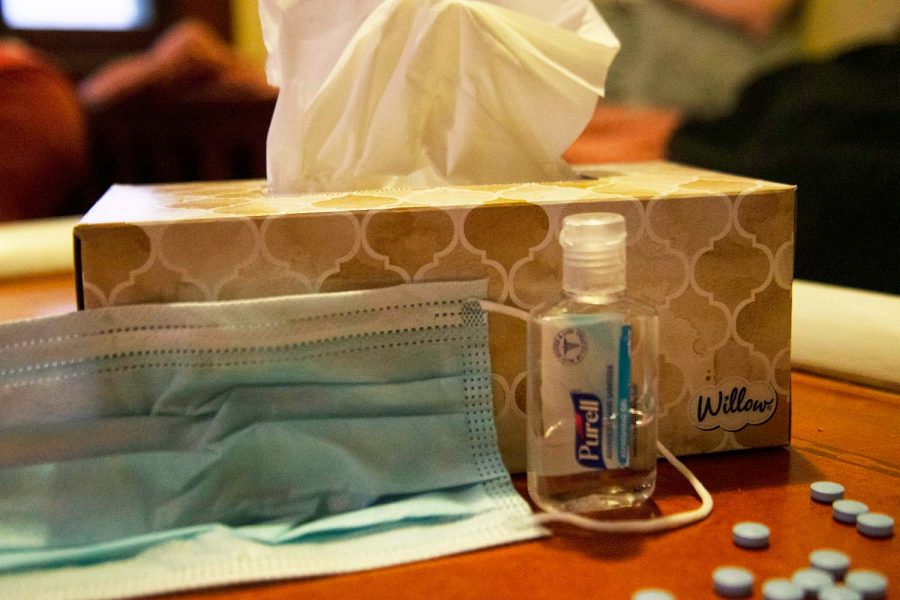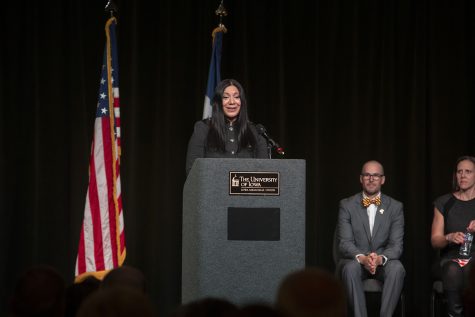UI students, staff work to accommodate absences as non-COVID-19 illnesses tick up on campus
The University of Iowa Student Health Center has seen an increase in the number of students showing up with coughs, sore throats, pink eye, and colds.
November 11, 2021
The University of Iowa Student Health center is seeing a rise in non-COVID-19 respiratory illnesses as the winter approaches, but it is reporting low numbers of influenza at this point in the season.
Lisa James, assistant director of quality improvement and strategic communication at Student Health, wrote in an email toThe Daily Iowan that campus health officials have seen non-COVID-19 related illnesses last for over a week.
“We are seeing lots of non-COVID upper respiratory infections — colds, coughs, sinus infections, pink eye, sore throats,” she wrote. “We often see respiratory illnesses as the seasons transition to cooler weather and more time indoors.”
James wrote that UI Student Health believes the spread of respiratory illnesses is happening because mitigation strategies that reduce and prevent the spread of respiratory communicable illnesses are no longer in place.
“Last year, masks and social distancing, added attention to handwashing, probably kept our incidence of these illnesses low,” James wrote. “Because of our lack of exposure and without that particular stress on our immune systems, perhaps we are more susceptible to these illnesses this year.”
The attempt to stop the spread of COVID-19 may have been the cause of the low spread of respiratory illness last year, she wrote. The appearance of respiratory illnesses and viruses is not uncommon for this time of year, she added.
“It is pretty typical of a fall season to see lots of colds and upper respiratory infections. We have NOT seen influenza yet on campus, and very low levels in the state of Iowa so far,” James wrote. “There is still time to get a flu shot! Getting both the flu shot and the COVID-19 shots will help keep our campus healthier.”
According to the Centers for Disease Control and Prevention weekly U.S. Influenza Surveillance Report, seasonal influenza activity in the U.S. is low, while the number of influenza virus detections reported by public health laboratories has increased.
Grahm Schneiter, a UI first-year student, said he caught a respiratory illness in early October.
“I was sick for around a week,” Schneiter said. “I didn’t go to the doctor, but I took a COVID test and that tested negative.”
Schneiter said he decided to go home, because he would rather be sick at home and be more comfortable there than at school. His symptoms the first day really worried him, he said.
“I was lightheaded, had a sore throat. I had loss of taste and smell,” Schneiter said. “That was the big one.”
Because of the duration of his illness, Schneiter did end up missing class time, he said, but felt his teachers were helpful during the process.
“I did miss some classes, some of them were online though. My teachers were good at responding to my emails so that I could stay up to par with the rest of the class,” he said. “They were very clear on how I could stay up to date, what things I needed to get done, what resources I could access.”
In the end, Schneiter said he recovered by just laying low.
“I’m the type of person to just kind of ride it out,” he said. “Stay hydrated and get tons of rest is my recipe for success when it comes to getting sick.”
Marcus Leyton, a graduate teaching assistant in the department of communication studies, said that he has seen more absences this year than in his past two years of being a teaching assistant.
“We do encourage students that if they’re feeling sick at all to email us and let us know that they’re not feeling well and we excuse them from class for the day,” Leyton said. “We’d rather keep everybody healthy than somebody show up with a cough and it turns out to be COVID.”
Leyton said he has 75 students across three discussion sessions, and he averages about six to 10 emails per week from students saying that they are sick.
“I work with the students once they’re feeling better,” he said. “Since it’s a discussion section, it’s usually a matter of making sure that they’re caught up on their readings and making sure that they’ve watched the lecture and they know what they’re doing for upcoming assignments.”
The number of students who are missing class due to illness is more stable than at the beginning of the year, Leyton said.
“It was really erratic, like there’d be some weeks where I would have full attendance, the next week I’d be missing a third of the class. I think as the semester’s gone on, at least from the classes that I teach, I think we’ve stabilized,” he said.
Leyton said he thinks the biggest factor that could change sickness rates is the upcoming Thanksgiving break.
“With so many students going home for Thanksgiving in just over a week, it’ll be interesting to see what happens, especially with so many final exams and final papers that are due,” he said. “We only have two weeks once we come back and if we see a spike, I think it might cause a bit of headache for both students and TAs.”
Overall, these illnesses are mostly viral and are not responsive to antibiotics, James wrote, so over-the-counter medications like Tylenol or Ibuprofen, sometimes nasal decongestants, lots of fluid and rest are the best medicine for recovery.
Washing hands, covering coughs, making sure to stay home and away from others when you are sick are also important ways to stay healthy and avoid getting sick, she wrote.
“Keeping the immune system as strong as possible is important, especially as students head into times of increased academic stress and demands as the semester goes on.” James wrote.





















